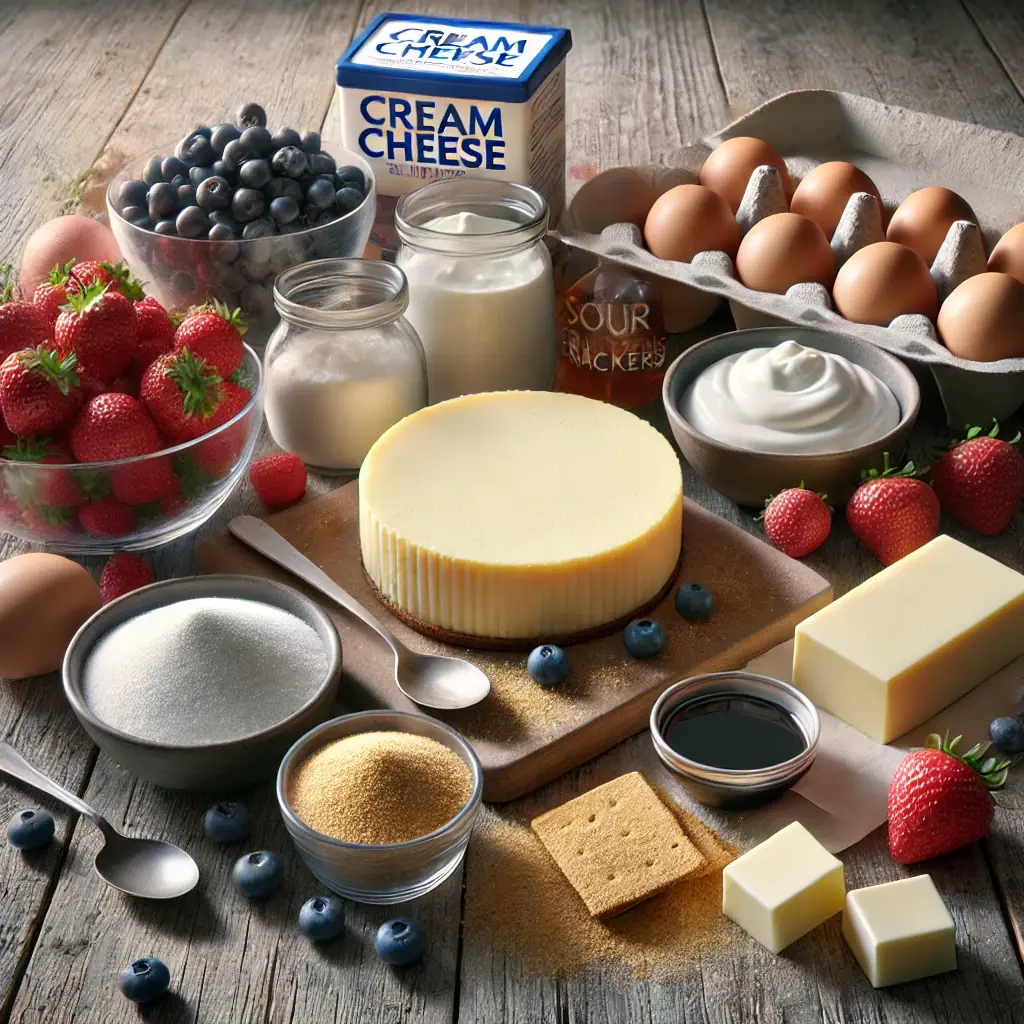Cream Cheese: Culinary Classics’ Velvety Secret
Few ingredients manage to blend richness, versatility, and comfort quite like cream cheese. Whether it’s the creamy core of a New York cheesecake, the smooth spread on a warm bagel, or the hidden star in savory dips and frostings, cream cheese has earned its place as a pantry essential in homes across the globe.
With its luxurious texture, mild tang, and chameleon-like adaptability, cream cheese is loved in kitchens from Tokyo to Toronto. It’s a staple for festive occasions, casual brunches, and refined desserts alike. More than just a spread, it’s a foundation—quietly carrying the flavor load in both sweet and savory dishes. Let’s take a deep dive into this beloved dairy delight, and discover what makes cream cheese a timeless treasure in the world of food.
🧀 Key Takeaways
- Origin: Believed to have originated in Europe, it was popularized in the U.S. in the 19th century and is now used worldwide.
- Main Ingredients: Primarily made from milk and cream, with added lactic acid bacteria for fermentation.
- Preparation Method: Fresh cheese that’s made through pasteurization, curdling, and smooth blending.
- Serving Style: Used in spreads, fillings, frostings, dips, and baked goods; typically served cold or incorporated into hot dishes.
- Variations: Flavored versions with herbs, fruit, or spices; vegan cheese alternatives made from nuts or tofu.
- Nutrition: A good source of fat and vitamin A, with variations in fat content (regular, low-fat, or fat-free).
- Customizability: Can be easily flavored or sweetened for specific recipes—ideal for both beginners and gourmet chefs.
🌍 Cream Cheese Through the Ages: A Bite of History
Cream cheese, while often associated with American cuisine, has European roots. Early forms of it appeared in England and France as early as the 16th century. However, the cheese we know today gained popularity in 1872, when William Lawrence of New York accidentally created it while attempting to replicate a French Neufchâtel cheese.
The Philadelphia brand—now synonymous with cream cheese—emerged shortly after and helped cement the product as a household name. Over the decades, cheese became a staple in Jewish-American cuisine (think bagels and lox), Southern baking traditions, and modern fusion cooking.
Today, it’s celebrated in:
- American cheesecakes
- Japanese cotton cheesecakes
- Middle Eastern desserts like kanafeh
- Mexican dips like creamy jalapeño salsa
Its cultural footprint continues to expand, evolving alongside dietary trends and regional preferences.
🛒 Essential Ingredients for Homemade Cream Cheese
To make traditional cream cheese from scratch or to better understand store-bought varieties, here are the core ingredients:
- Whole Milk and Heavy Cream: The foundation for richness and smooth texture.
- Lactic Acid Bacteria or Lemon Juice/Vinegar: To curdle the milk and create that subtle tang.
- Salt (optional): Enhances flavor.
- Optional Add-ins: Garlic, chives, honey, or fruit purée for flavored versions.
Recommended Brands:
- Philadelphia Cheese (for classic flavor and texture)
- Arla Cream Cheese (milder, natural taste)
- Tofutti or Kite Hill (vegan alternatives made with tofu or almond milk)
🔪 Preparation Techniques: From Milk to Magic
Homemade Cream Cheese Method:
- Heat the milk and cream gently over medium heat until just below boiling.
- Add acid (lemon juice or vinegar) and stir slowly. The mixture will begin to curdle.
- Let it sit off-heat for 10–15 minutes until curds form.
- Strain using a cheesecloth to remove whey. This step can take 8–12 hours for the best texture.
- Blend the curds until smooth and creamy.
- Season with a pinch of salt or mix in flavorings.
Marination Tips: For flavored versions, let the cream cheese rest in the refrigerator for several hours after blending with herbs or spices to deepen the flavors.
🧂 The Secret to Authentic Flavor
Authentic cream cheese relies on balance—not too tangy, not too bland. Here’s how to hit the flavor sweet spot:
- Use full-fat dairy for best mouthfeel.
- Add a touch of salt to bring out subtle dairy notes.
- Incorporate fresh herbs like dill, chives, or parsley for savory spreads.
- Sweeten lightly with honey, maple syrup, or powdered sugar for desserts.
- Use a food processor for velvety smoothness.
💡 Tip: Let the cream cheese rest at room temperature for 10–15 minutes before using to unlock its full flavor.
👨🍳 Step-by-Step Cooking Guide: Making Classic Cheesecake with Cream Cheese
Want to make a show-stopping dessert using cheese? Here’s a tried-and-true classic cheesecake recipe:
Ingredients:
- 2 cups graham cracker crumbs
- 1/2 cup melted butter
- 1/4 cup sugar
- 4 (8 oz) packs cream cheese, softened
- 1 cup sugar
- 1 tsp vanilla extract
- 4 large eggs
- 1 cup sour cream

Instructions:
- Prepare the crust: Mix crumbs, melted butter, and sugar. Press into a springform pan and bake at 325°F (160°C) for 10 minutes.
- Make the filling: Beat softened cream cheese until smooth. Add sugar and vanilla. Mix in eggs one at a time. Fold in sour cream.
- Bake: Pour filling into crust. Bake at 325°F for 55–65 minutes until the center is slightly jiggly.
- Cool slowly: Let it cool inside the oven with the door slightly ajar for 1 hour to prevent cracking.
- Chill: Refrigerate at least 4 hours before serving.
❌ Common Mistakes to Avoid
- Using cold cheese: It won’t blend smoothly. Always soften first.
- Overmixing the batter: Can lead to a cracked or dense cheesecake.
- Skipping room-temperature ingredients: Causes uneven texture.
- Adding too much liquid: Dilutes the creamy richness.
✔️ Solution: Use high-quality, full-fat cream cheese and follow measurements carefully.
🥗 Perfect Pairings: What to Serve with Cream Cheese
Cream cheese plays well with others. Here are popular companions:
- Bagels with smoked salmon, capers, and red onions
- Crackers and veggie sticks with herb cream cheese dip
- Scones or banana bread with whipped sweet cream cheese
- Spicy jalapeño poppers filled with seasoned cheese
- Fresh fruit (berries, figs, or grapes) with honeyed cream cheese
For drinks, try sparkling water, coffee, or a glass of prosecco if you’re indulging.
🧊 Storage & Reheating Tips
- Fridge Life: Store in an airtight container for up to 10 days.
- Freezing: Yes! Wrap tightly and freeze for up to 2 months. Thaw overnight in the fridge and re-whip for best consistency.
- Reheating (for dishes): Gently reheat cream cheese-based dishes over low heat, stirring constantly to prevent curdling.
📝 Conclusion: Your Turn in the Kitchen!
Whether you’re spreading it, whipping it, or baking it into a luscious dessert, cream cheese has a place in every kitchen. Its simplicity and depth make it a blank canvas for creativity and tradition alike.
Now it’s your turn! Try making your own cream cheese or crafting a homemade cheesecake. Share your culinary adventures in the comments—what’s your favorite way to use cream cheese? Have a family recipe to pass down? We’d love to hear from you.
❓ Frequently Asked Questions (FAQ)
Q: Can I substitute cream cheese with something else?
A: Yes. For savory dishes, try ricotta or mascarpone. For vegan options, cashew or almond-based spreads work well.
Q: How can I make it vegan or dairy-free?
A: Use plant-based milk and cream, with lemon juice for curdling. Or buy vegan cream cheese brands like Miyoko’s or Kite Hill.
Q: How do I scale the recipe for a party?
A: Simply double or triple the recipe, but use larger pans or divide into multiple smaller portions for even baking.
Q: Are there any popular variations?
A: Absolutely—fruit-flavored cream cheese, jalapeño cream cheese, or sweet spreads like pumpkin spice during the holidays.
📣 Let’s Get Creamy!
We hope you’re feeling inspired to bring this kitchen classic to life. Drop your favorite cheese recipes or flavor combos in the comments below—and don’t forget to share this article with your fellow food lovers!







